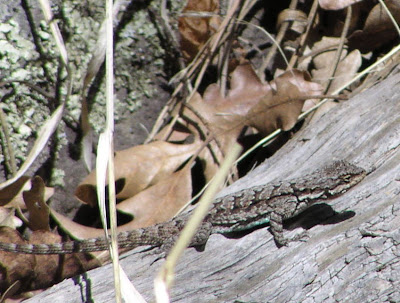
Wow what a place!! This birding secret I am going to keep! I have never seen so many different kinds of birds in such large numbers. I am not going to name this campground. Two days of birding has added a lot of new birds to my life list including a rare tropical bird that nests in the Mexico and only a very few mountain valleys of southern Arizona. We are nestled in a narrow canyon with a forest “scrub” Oak, Arizona Sycamore, Juniper, and pine. The deep, rocky sided, valley we walked up had HUGE Arizona Cypress which are very rare in the U.S, with a mixed forest that had other tall conifers mixed with the shinning whine trunks of the Sycamores. There was a rocky creek that ran through it sometimes with significant water, sometimes dry. The wall were sheer rock faces that did not let the sun into the floor until about 9:00AM.
Here are Richard and Duncan standing beside a very large Arizona Cypress
Our most exciting discovery in that valley were Elegant Trogons. We saw two males. These are a rare tropical bird that is native to Mexico and only a few canyons in southern Arizona. My picture is very poor at best - he was very hard to see in the shade of the thicket of tree branches. We found him only by his odd call. But we could see that his back was coppery green and we got a glimpse of his bright pink breast.
Everywhere we looked were new birds that are never seen at home. It was really strange to find Chipping Sparrows, a common native of home too, in large flocks. There were no House Sparrows and no Starlings. But some of the birds that were new for me on this trip were not here. The list for this place is long.
The Acorn woodpeckers were fascinating with their clown like coloring of Red, Black, and white and their raucous flocks that tumbled through the woods, like a band of preteen boys.
Another camper had put out orange halves and hummingbird feeders. They attracted Bullocks Orioles and Scott's Orioles which are yellow instead of orange. Broad tail, Black Chin, Blue Throated, and Magnificent Hummingbirds were at the feeder.
I also saw a Green Tailed Towhee, White Winged Doves, Gray-Breasted Jays, Pinion Jays, Steller's Jays. Ravens. Audubon's Warbler which is now lumped with the Yellow Rumped, Townsend's Warbler, Wilson's Warbler, Painted Redstart, Western Tanager, Hepatic Tanager, Black Headed Grosbeaks, flocks of Lark Sparrows, Yellow Eyed Junco,




















